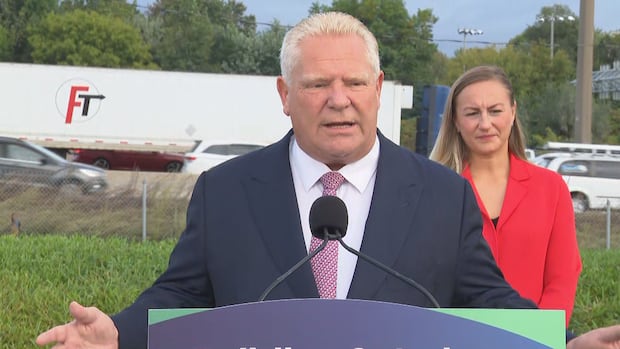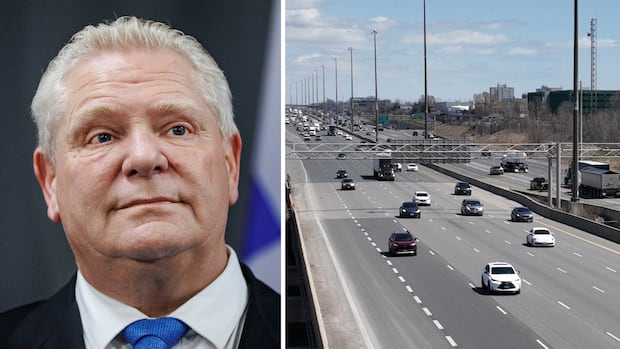
As Doug Ford’s Ontario government considers building a tunnel under Highway 401, the provincial Green Party and an advocacy group say there’s a far more obvious solution to tackling Toronto’s gridlock: making better use of the express toll route 407.
Ford says an underground expressway beneath the 401 would ease gridlock on the congested Greater Toronto Area highway by expanding its capacity for drivers and transit. The tunnel could run roughly 55 kilometres, would not be tolled and would include public transit, the province has said.
Ford didn’t provide a cost estimate for the tunnel, but said Wednesday that he doesn’t think the project would cost “hundreds of billions of dollars.”
The premier said that the tunnel is a “serious plan to get drivers out of gridlock.” But Ontario Green Party Leader Mike Schreiner says there are quicker, cheaper and more effective alternatives, like getting more truckers off the 401 and onto the privately owned 407 by subsidizing their tolls.
“We’ve got an underutilized highway right there that we could use tomorrow — not 10, 20, 30 years from now. We could actually start using it tomorrow,” Schreiner said in an interview with CBC Toronto.
He said it was a mistake that the highway was originally sold in the 1990s and added he’d be open to the province buying it back.
“We’d have to make sure the price would be right. We need to make sure that, you know, we end gridlock in a financially responsible way,” he said. Schreiner added that he has no idea how much such a purchase might cost.
The idea to subsidize tolls isn’t new — Schreiner and others have been advocating for it for years.
Premier Doug Ford announced Wednesday his government will explore the possibility of building a tunnel for drivers and transit beneath Highway 401.
In 2020, the public transit advocacy group Transport Action Ontario used provincial and 407 ETR data to examine how a toll subsidy could impact traffic. At the time, the group estimated that such a move would get between 12,000 and 21,000 trucks using the toll highway each weekday.
“We would immediately see, I think it’s about a 30 per cent reduction in vehicle volume on the 401,” said Peter Miasek, president of Transport Action Ontario, in an interview Thursday.
“Each truck takes up probably the equivalent of two or three cars. So it’d be quite a dramatic reduction.”
Trucking association not a fan of subsidy proposal
While the idea is meant to benefit both drivers and truckers, the Ontario Trucking Association called it “impractical” in a statement published earlier this year and praised Ford’s tunnel proposal on Wednesday. The association said the 407 toll subsidy idea doesn’t take into account that some day, the 407 would end up just as congested as the 401.
The province also takes issue with the idea’s long-term feasibility. A spokesperson for the office of Prabmeet Sarkaria, Ontario’s transportation minister, said the 407 will be at or above capacity in the next 10 years.
“By 2031, we would experience similar congestion problems even if Highway 407 was expanded, tolls were subsidized and truck priority lanes were included,” Dakota Brasier said in an email.
But Schreiner said the subsidies could be combined with other solutions like more frequent transit service.
When it comes to tolls and congestion, there is also an alternative option, according to Matti Siemiatycki, director of the Infrastructure Institute at the University of Toronto.
Premier Doug Ford’s proposed plan to build a tunnel under Highway 401 is being met with skepticism at City Hall. Experts warn construction will take years and cost billions. CBC’s Shawn Jeffords breaks it down.
He said tolls could be placed on other major roads like the other 400 series highways, Gardiner Expressway and Don Valley Parkway.
“That would be another way that very quickly you could free up capacity, encourage people to carpool, encourage people to take public transit and raise revenue,” he said.
Company behind 407 says it’s not involved in policy
The subsidy idea is not a new one. Schreiner said he’s been calling for it for years and said the government would rather focus on large projects than practical solutions.
Tolls on the privately-owned 407 ETR vary depending on the time of day and the particular stretch of highway. Between 12 a.m. and 11 p.m. the per-kilometre price for a typical transport truck ranges from 99 cents to $1.95.
Implementing subsidies would have to be done through a deal with the highway’s operator.
A spokesperson for the Highway 407 ETR said as a private road operator, the company is not involved in policy discussions beyond its sales agreements with the province.
“[We] regularly discuss and plan — internally and with our partners — how best to achieve our mandate to relieve congestion on alternate routes in the province,” said Christina Basil, 407 ETR’s vice president of communications and government relations.

